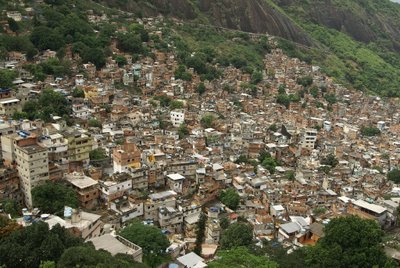-
In Rio de Janeiro, an Opportunity to Break Barriers
January 23, 2009 By Will Rogers The city of Rio de Janeiro’s plan to erect a 650-meter long, three-meter high concrete wall between the 7,500 residents of the Dona Marta slum and the surrounding rainforest signals the government’s reluctance to address the underlying causes of environmental degradation. Although it is heralded by authorities as an “eco-barrier” that will protect the rainforest and “improve living standards and protect slum residents from the armed gangs that control many of Rio’s 600 or so slums,” the wall does not address the issues of acute poverty and lack of access to affordable housing that keep many Brazilians living in slums, harvesting resources from the rainforest.
The city of Rio de Janeiro’s plan to erect a 650-meter long, three-meter high concrete wall between the 7,500 residents of the Dona Marta slum and the surrounding rainforest signals the government’s reluctance to address the underlying causes of environmental degradation. Although it is heralded by authorities as an “eco-barrier” that will protect the rainforest and “improve living standards and protect slum residents from the armed gangs that control many of Rio’s 600 or so slums,” the wall does not address the issues of acute poverty and lack of access to affordable housing that keep many Brazilians living in slums, harvesting resources from the rainforest.
Without access to decent housing and living-wage jobs, many slum residents will continue to encroach on the hillsides, warn Brazilian environmentalists. “It is hypocrisy to talk about protecting the Atlantic rainforest without considering the issues of housing and transport to take the pressure off the forest,” said Sergio Ricardo, a leading environmental campaigner in Rio de Janeiro, in an interview with the Jornal do Brasil.
Slums have often stalled Rio’s efforts to improve its environmental report card, as slum residents tend to be focused more on daily survival than on the environmental consequences of their actions. But slums do not have to be a thorn in the side of the government’s eco-friendly image. In fact, Rio’s previous attempts to reverse deforestation through grassroots reforestation projects have been extremely successful.
According to a 2005 article in the San Francisco Chronicle, municipal reforestation projects around Rio employed several hundred slum residents to plant millions of trees surrounding their communities. The projects “resulted in the return of dozens of species of birds, monkeys and other animals—many not seen in decades,” as well as cooler air temperatures, writes William Bennett. At the same time, the municipal projects became a source of steady work for residents. “Before this job, I worked as a day laborer; one day I would have work—the next day nothing,” said Carlos Alberto Ribeiro, a reforestation worker who earned about $200 a month planting trees. By 2005, community reforestation projects had employed 914 slum residents in 93 projects that had restored a total of 4,500 acres of native-species trees to the region.
Rather than segregating slum residents from the rest of the city in what some critics have called “social apartheid,” perhaps Rio should scale up community forestry projects, employing greater numbers of slum residents to improve the health of the Atlantic rainforest. While the government still has far to go in providing affordable housing, a steady wage could help residents secure access to adequate housing and reduce pressure on the region’s delicate environment.
Photo: Rocinha, one of Rio de Janeiro’s largest slums with an estimated 200,000 residents, is one of hundreds of slum neighborhoods surrounding Rio, putting extreme pressure on the region’s environment. Courtesy of flickr user andreasnilsson1976.
Topics: Brazil, development, environment, forests, Latin America, livelihoods, population, poverty, urbanization
 A Publication of the Stimson Center.
A Publication of the Stimson Center.

 The city of Rio de Janeiro’s plan to erect a
The city of Rio de Janeiro’s plan to erect a 

